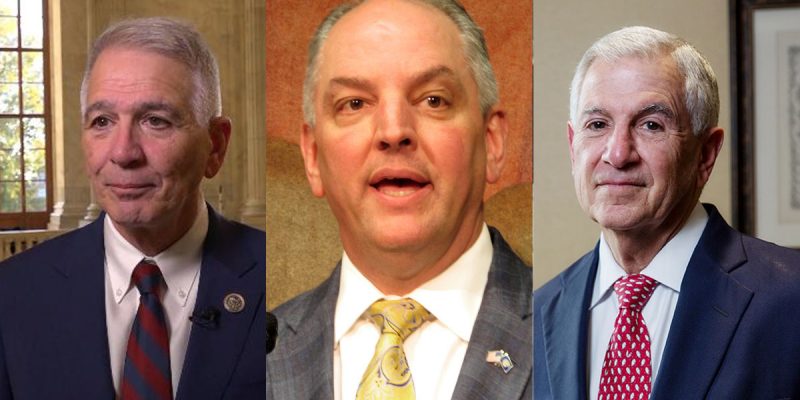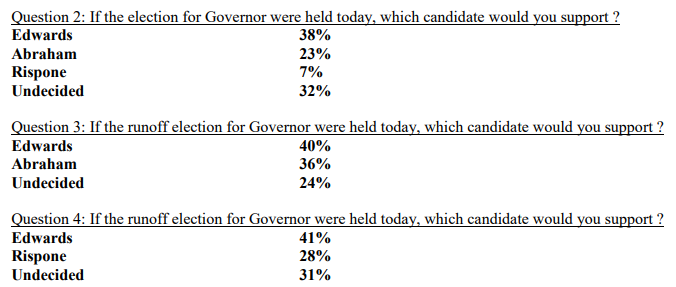One of the most irritating things we keep hearing as we run the roads around Louisiana on The Hayride’s 2019 @Large Tour and otherwise is that John Bel Edwards is set to cruise to re-election this fall. Most of the time when that canard is brought to us we’re able to at least cast some doubt on it if not eliminate it entirely, but it continues to persist. And a poll released this morning by Baton Rouge-based JMC Enterprises, owned and operated by our friend John Couvillon, proves that anyone who thinks Edwards isn’t exceptionally vulnerable simply isn’t paying attention.
We’ll get to the numbers shortly, but first, let’s go through the reasons why nobody should even assume Edwards’ re-election is likely. We addressed these in a post here at The Hayride a month ago, but the fundamentals of the race work against Edwards. To wit…
- No Democrat governor has been re-elected in Louisiana since 1975, and the circumstances which led to Edwin Edwards’ re-election that year were totally different than now – specifically the state was in an oil boom economy then, and there was no Republican Party in Louisiana to speak of at that time.
- The history of Louisiana gubernatorial elections indicates the state’s voters far more often opt for “long shot” candidates than the early-race favorites. Ralph Abraham and Eddie Rispone are no more implausible than Dave Treen, Buddy Roemer, Mike Foster, Kathleen Blanco or John Bel Edwards were.
- JBE’s $10.2 million in the bank is a sizable stash of money, but Rispone has even more cash on hand. And for all the talk about how short-stacked Abraham is at just over a million bucks in his war chest, that’s considerably more than Edwards had at this time four years ago – not to mention that once the runoff begins the national money flowing into this race will make sure that whoever makes the runoff against Edwards will have more than enough cash to get a message out.
And then there’s the polling of the race, which has consistently shown that while Edwards leads Abraham and Rispone, he can’t get above 50 against either of them despite the fact neither one has the name ID at this point they’ll have later this year when voters start really paying attention to the campaign. Edwards’ approval ratings haven’t touched 50 percent in over a year and they’ve been sagging, and it’s beginning to look like he has a ceiling in the mid 40’s which every statewide Democrat candidate in the past decade has crashed against with the exception of his 2015 race against David Vitter.
That exception, fairly obviously, had more to do with Vitter than with Edwards. Vitter’s special weaknesses, which Edwards exploited, are not present with either Abraham nor Rispone, nor is the Abraham-Rispone relationship toxic in the way Vitter’s relationship with fellow Republican candidates Scott Angelle and Jay Dardenne in 2015 was.
But Edwards’ poll numbers have been considerably stronger in previous polling than they are in Couvillon’s new survey – something we have an explanation for. But first, Couvillon’s poll results…
The first question was on President Trump’s approval rating (which was 54-37 positive).
Here’s a little of Couvillon’s analysis of the poll results…
While John Bel Edwards was elected governor in 2015 in a 56-44% near landslide, his ballot test numbers are nowhere near that strong this year. When you consider that neither of his two declared Republican opponents (Ralph Abraham and Eddie Rispone) has begun to spend money on mass media, Governor Edwards is not only well below 50%, but his support number (regardless of the ballot configuration) hovers around 40%, which (especially with minor candidates who will jump into the race by the conclusion of qualifying) almost guarantees that the race will go to a runoff.
More specifically, when analyzing these three ballot test combinations (Edwards/Abraham/Rispone, Edwards/Abraham, and Edwards/Rispone), a fairly inelastic electorate is apparent. Overall, Governor Edwards’ support ranges from 38% in a three way race to 41% against Rispone. His (Edwards’) Republican support ranges from 14-17%, his black support is between 71-75%, his white Democratic support is between 40-45%, and his white Independent support is between 27-31%.
Where there is more of a separation of support (in addition to racial and partisan lines) is by region. In Baton Rouge/New Orleans/Lake Charles, Edwards’ support varies from 44 to 46% (depending on the ballot configuration), while in the rest of the state, his support is a noticeably lower 30-34%, and it is in the opinion of the pollster that the larger media markets (as well as Lake Charles) have seen a greater degree of economic activity/expansion than the rest of the state has, thus making those regions experiencing economic growth more likely to support the incumbent. Incidentally, a review of the 2015 results revealed a similar split: Baton Rouge/New Orleans/Lake Charles (where 62% of the vote was cast) supported Edwards 59-41%, while the remainder of the state supported Edwards 51-49%. Finally, there is a gender gap which varies from 9 points (Edwards/Rispone) to 18 points (three-way race).
Couvillon’s poll more or less puts to bed the theory that Edwards is going to win the race in the October primary. If he’s sitting at 38 percent in a three-way race now, after almost three and a half years as governor, he’s not going to find 12 or 13 percent of the vote who fall in love with him in the next five months when two other candidates are beating him up every day. Does anybody really think he’s going to get a third of that 32 percent undecided? The vast majority of those people are undecided between Abraham and Rispone, not either one of them and Edwards.
And if you’ve paid attention to the other early polls on the governor’s race you’ll notice that Edwards polls a good bit worse in this one compared to those, where Edwards was getting 47-48 percent in head-to-head matchups with his challengers. The temptation is to see this poll as reflecting a negative direction in the public’s response to Edwards. There might be a little of that going on, as clearly Edwards has had a bad couple of weeks, but it’s explainable by a lot simpler reason.
Namely, that Couvillon’s is the first poll on this race which doesn’t greatly oversample Democrats.
Back in December, the pro-JBE Education Reform Now group put out a poll which had 53 percent of its respondents as Democrats. And the two Remington polls, both in December and again in March, that Abraham’s camp released inexplicably have Democrats as 50 percent of their samples.
Advertisement
The fact of the matter is Democrats are only 46 percent of the registered voters in the state. And it’s true that they can overrepresent that number in Louisiana elections. In fact, Democrats have been more than 50 percent of the voting electorate in three statewide elections over the past four years. They were 50.4 percent of the vote in the November 2017 Treasurer’s race runoff, and they were 51.1 percent of the vote in the October 2015 gubernatorial primary and 51.4 percent of the vote in the November 2015 gubernatorial runoff. Those were all special circumstances, however; the November 2017 election was a low-turnout affair save for the fact that election date carried the New Orleans mayoral runoff between LaToya Cantrell and Desi Charbonnet, which skewed the electorate. And the two 2015 election dates were all about how much Democrats hated David Vitter and came out of the woodwork to vote for him.
In other elections where it’s more of a straight R-vs.-D situation, Democrats don’t get to 50 percent. They were just 44.7 percent of the vote in the November 2016 presidential election in the state, they were 45.2 percent of the vote in the 2018 congressional elections, they were 47.2 percent of the vote in the December runoff for Secretary of State last year, they were 48.6 percent in the Treasurer’s race primary in October 2017 which coincided with the New Orleans mayor’s race primary, and they were 47.4 percent of the vote in the December 2016 Senate runoff.
In an ordinary statewide race, figure on Democrats being about the same share of the vote as they are in voter registration – 46 percent.
Couvillon perhaps undersamples Democrats a bit at 43 percent. But that’s likely, or at least plausibly, closer to the real number than 50 or 53 percent as those other polls pegged the D’s to be. And if Couvillon is correct about the makeup of the electorate this fall, Edwards can’t get to 50. Period.
So that’s the state of the race. The governor is in trouble and loses if either Abraham or Rispone runs even so much as a competent campaign – which based on the resumes of their teams is perfectly foreseeable.
Advertisement
Advertisement


